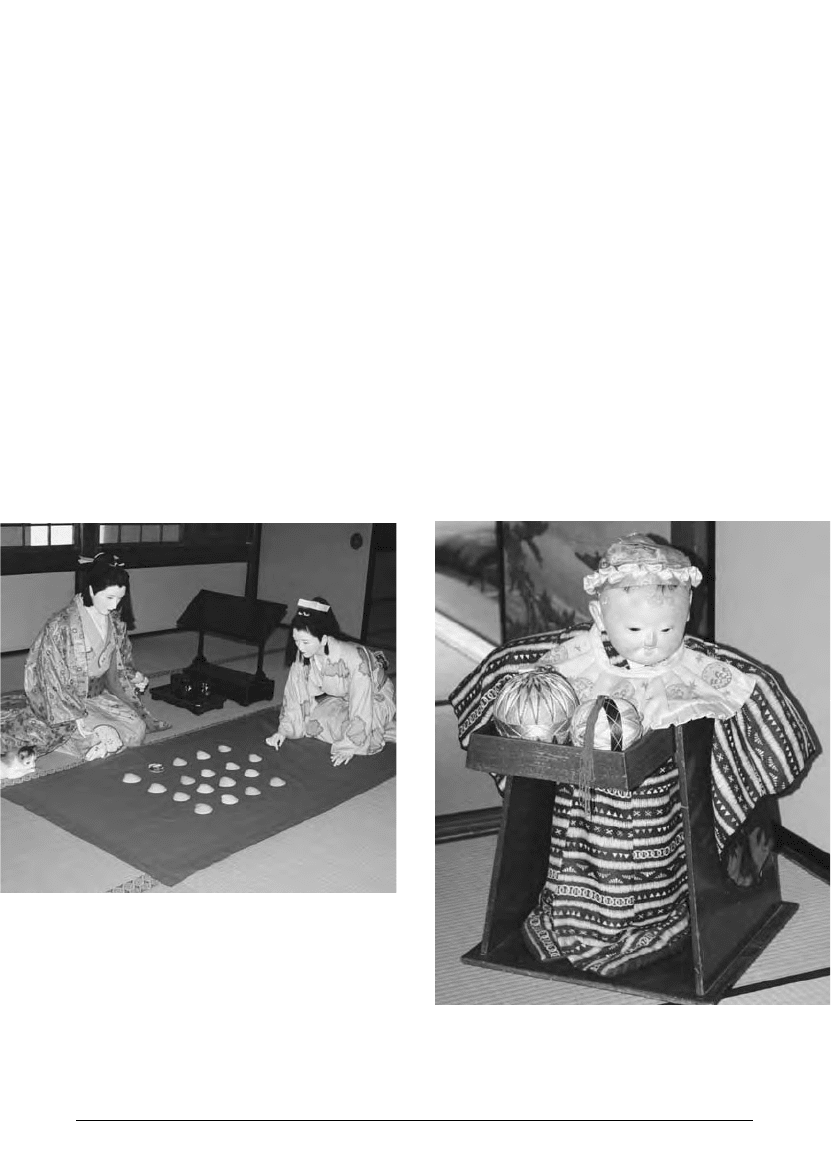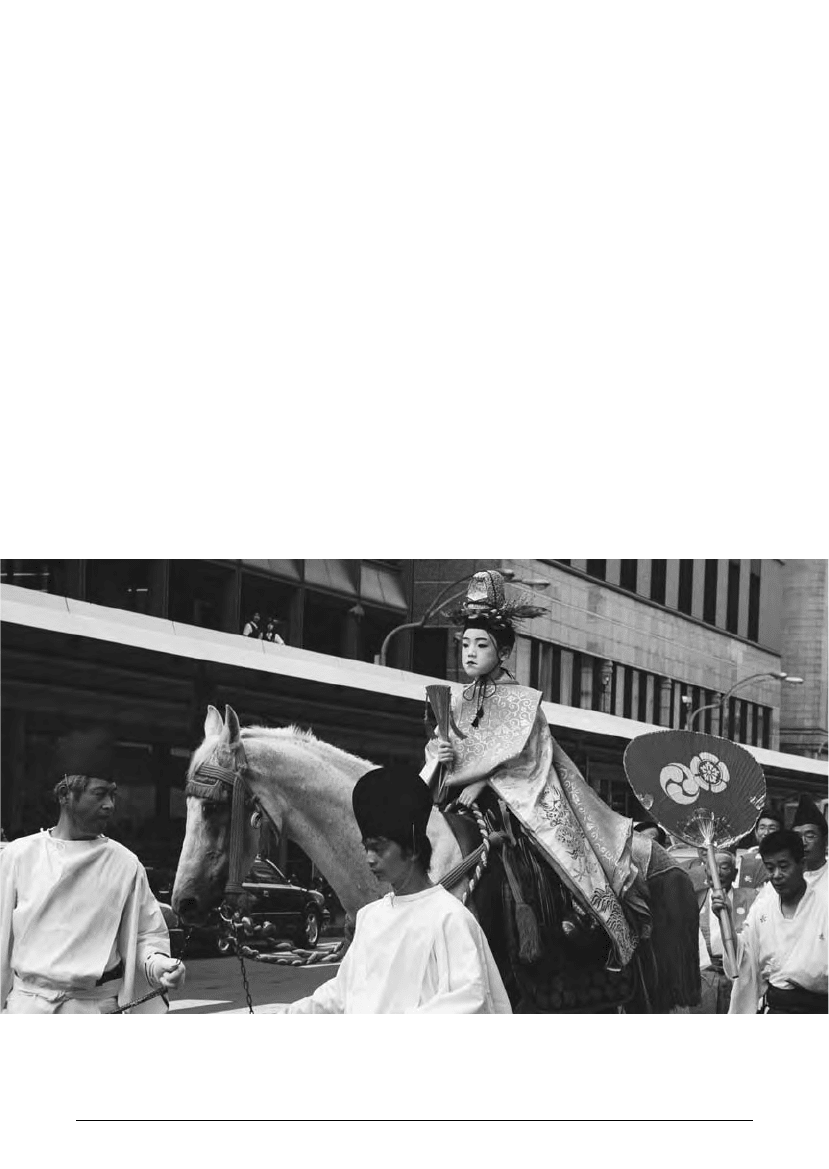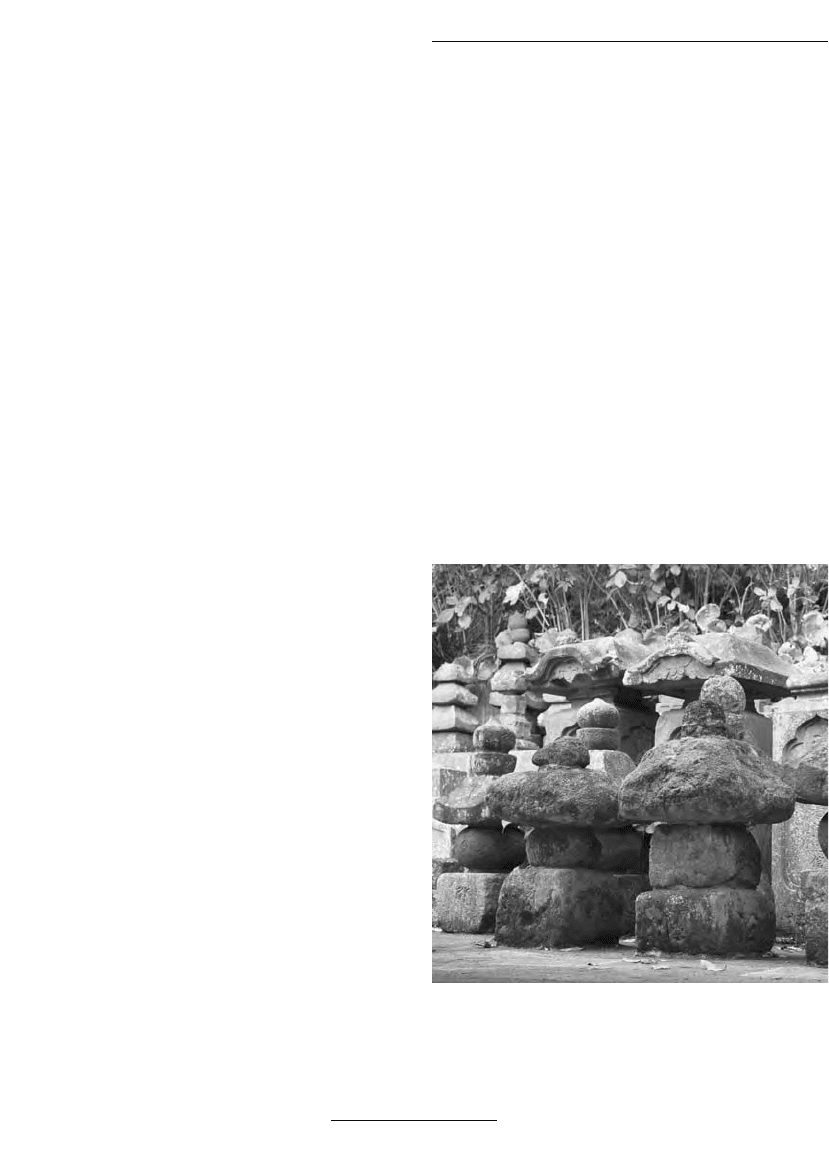Deal W.E. Handbook To Life In Medieval And Early Modern Japan
Подождите немного. Документ загружается.


Besides board games, card playing was also a
common pastime. Two popular forms were the uta
karuta (poem cards), a game played with cards on
which a famous poem is written, and hanafuda
(flower cards), a game played with cards depicting
flora and fauna. Card playing was often associated
with gambling, both of which were banned by the
Tokugawa shogunate after a dramatic increase in
such activity.
Children’s play during the medieval and early
modern periods included the following games:
MENKO
Dating back to the Kamakura period, menko was a
game in which a player placed a game piece on the
ground. An opponent would try to flip the piece
over by flinging another game piece at the one on
the ground. These game pieces, made of clay or
some other material, were usually decorated. In the
Edo period, images of sumo wrestlers became a pop-
ular subject for the pieces.
KAGOME KAGOME
“Bird in a cage” game. This was a guessing game in
which children formed a circle around a child and
sang a song called “Kagome kagome.” While the
song was being sung, the children moved in a circle
around the child in the middle. When the song
ended, the children stopped circling and the one in
the middle tried to guess who stood immediately
behind him or her. A correct guess released the child
from the circle (or the bird from the cage), replaced
by the child whose identity had been guessed.
NEKKI
In this game, a one-foot-high wooden stake is placed
upright into the ground. The object of the game is to
knock down the stake by throwing a stick against it.
JANKEN
This is a game of “rock, paper, scissors.” Pairs of
children would say “jan, ken, pon” in unison and then
H ANDBOOK TO L IFE IN M EDIEVAL AND E ARLY M ODERN J APAN
354
12.11 Princess Sen, eldest daughter of the second Toku-
gawa shogun Hidetada, engaged in an aristocratic pas-
time called kaiawase. From the Heian period, this
traditional game involved players competing to identify
shells with matching scenes or poems taken from classical
literature.
(Himeji Castle exhibit; Photo William E.
Deal)
12.12 Example of an Edo-period toy doll (Photo
William E. Deal)

hold out their hands. A closed fist was a stone, a
hand held out flat was paper, and a hand with two
fingers extended was scissors. Paper covered stone,
stone broke scissors, and scissors cut paper.
Other forms of leisure and entertainment found
throughout the medieval and early modern periods
included nazo nazo, the recitation of funny riddles
that became very popular during the Edo period,
and origami, the art of paper-folding to create intri-
cate shapes and figures. Flying elaborately decorated
kites, playing with children’s tops, and collecting
dolls that were often used in ceremonial celebrations
were additional leisure activities.
Household Pets
Children in medieval and early modern Japan rarely
possessed household pets. If an animal was cared for
by a human, it was usually because the animal served
some useful purpose. Insects such as crickets, valued
for the soothing effects of their chirping, and fire-
flies were often caught and kept in cages in Japanese
homes. Wild Japanese monkeys were sometimes
caught and trained to perform acts of entertainment,
such as dancing, for the public. With the exception
of some Pekinese dogs imported by the Dutch, dogs
in Japan were rarely kept as pets. Domestic cats,
imported into Japan in ancient times from China
and Korea, were rare and prized possessions until
the 10th century. However, by the Kamakura
period, they were fairly common in households as
vermin-catchers but not as treasured family pets.
The traditional Japanese breed of cat has been
described as short-haired, mostly white with black
and brown markings, and round-faced. Felines were
a common theme in traditional Japanese literature,
and folk beliefs revolved around the notion that cats
avenge themselves when killed.
Animals enjoyed significant protection under
Buddhism, which forbade the taking of any life. The
release of caged animals back into the wild was
highly regarded, and many people believed that such
an act would bring rewards in the next life. Mer-
chants on the street often sold live fish and caged
animals, such as birds and tortoises, specifically bred
or caught for this purpose.
CALENDAR
In the medieval and early modern periods, the
Japanese utilized the traditional lunar calendar.
Dates on this calendar represented the day, month,
and year, the last of which could be determined by
several methods. Two such methods included the
60-year time cycle and the use of the era name, or
nengo. Nengo was a unit of time comparable to an era,
commonly employed to date events or chronological
periods. The use of this measure of time began in
the seventh century. The change of emperor
included a change in era name. However, in the
early modern period, the nengo did not simply repre-
sent the duration of a governmental regime. New
era names might be declared when auspicious events
occurred or at certain points in the traditional 60-
year (sexagenary) calendar cycle.
Both telling time and naming months utilized
two separate methods. The time of day was typically
divided into 12 sections. Under the sexagenary sys-
tem, however, one set of six sections was not the
same time span as the other set. Likewise, months
had both formal or traditional names as well as alter-
native titles with symbolic folk meanings.
Despite the official use of the lunar calendar, the
solar calendar was also employed and was very
important for farmers. This calendar accurately pin-
pointed the seasons, and thus farmers depended
upon it to know the proper time for planting and
harvesting. In addition, the solar calendar was
important for the influence it had on the structure of
the traditional lunar calendar.
FESTIVALS AND
YEARLY RITUALS
As in other periods of Japanese history, festivals and
yearly rituals were important to the conduct of
everyday life in the medieval and early modern peri-
ods. Festivals (matsuri) have their origins in Shinto
E VERYDAY L IFE
355

rituals often associated with the agricultural cycle
and obtaining blessings from the kami for a plentiful
harvest and other benefits. Annual rituals (nenchu
gyoji or nenju gyoji) were related originally to the
imperial court calendar and date back to before the
medieval period. These annual rites often had a
Buddhist or astrological significance and were
intended to ensure the blessings of the Buddhas and
bodhisattvas, as well as the proper functioning of the
court. In the medieval and early modern periods,
especially with the reduced significance of the impe-
rial court, there came to be shared elements between
festivals and yearly events.
Festivals
Often tracing their origins to folk traditions, Japan-
ese festivals were numerous in the medieval and
early modern periods. Festivals existed in a multi-
tude of forms, and were present in all seasons and
regional locations. Despite the diversity of form, the
purpose of matsuri typically was to cultivate har-
mony within the local community and to effect
human-divine contact—often as a means to express
gratitude to the kami or to petition them for assis-
tance in agricultural matters. Because festivals were
often held to assure an abundant harvest, the occur-
rence of matsuri was tied to the seasonal cycle. Thus,
the most important celebrations occurred during the
spring and autumn to coincide with the planting and
harvesting periods. However, winter and summer
festivals were also held, the latter of which were
often rituals conducted to prevent the occurrence of
anything that might destroy the crops in midseason.
In the early modern period, city festivals arose as a
means to protect the population from epidemics and
natural disasters. Although there was obvious reli-
gious significance to matsuri, they also came to have
a more general celebratory tone and included events
such as dancing and contests.
Festivals included ritual elements that made it
possible to establish a connection between humans
and the kami. Among these rituals were rites of
purification and offerings to the gods of rice, sake,
H ANDBOOK TO L IFE IN M EDIEVAL AND E ARLY M ODERN J APAN
356
12.13 Scene of a Gion Festival parade in the streets of present-day Kyoto (Photo William E. Deal)

vegetables, and other nonmeat products emblematic
of an agricultural community. Purification, central
to Shinto conceptions of the sacred, was required of
both Shinto priests and festival participants before
they could engage in these rituals of thanksgiving
and supplication. One other common aspect of festi-
vals was a communal feast between people and the
gods.
Yearly Rituals
Yearly rituals had their origins in Buddhist and other
rites performed on a regular schedule by the imper-
ial court. Starting in the Kamakura period, however,
these rituals were diffused into the larger popula-
tion, and at least some of the rituals once performed
only at court came to be practiced more generally.
Yearly rituals were integrated into the cultural calen-
dar, so communities throughout different regions of
Japan came to observe them at similar times of year.
Over the course of the medieval and early modern
periods, the yearly ritual calendar was revised and
adapted to meet changing cultural and social needs,
reflecting the interests of warriors and other social
classes. This was especially the case in the Edo
period when merchant and artisan values informed
the kinds of rituals that were performed annually.
The following are examples of just a few of the
yearly rituals celebrated in the medieval and early
modern periods:
SETSUBUN (EVE OF THE FIRST DAY
OF SPRING)
The performance date varied from year to year
because the first day of spring was traditionally calcu-
lated using the lunar calendar. Also referred to as oni
harai (“sweeping away the demons”), Setsubun was a
ceremony in which beans were thrown both inside
and outside the house to ward off evil demons.
SHICHIGOSAN (SEVEN-FIVE-THREE)
Observed on November 15, Shichigosan was a ritual
for children at the ages of seven, five, and three. Boys
and girls of these ages were thought to be particularly
susceptible to malevolent forces, so they were taken
to a Shinto shrine to gain the blessings of the gods.
This ritual was believed to provide divine assurance
of a safe and prosperous future for children.
OBON (OR URABON-E, BON FESTIVAL)
Observed from July 13 to 15 (or from August 13 to
15 in some parts of Japan). The Bon Festival, dating
back to the seventh century in Japan but performed
prior to that in China, was a Buddhist practice in
which families honored their ancestors. Families
would welcome the souls of their ancestors back for
a three-day visit, at which time various rituals were
performed.
SHICHIYA (SEVENTH NIGHT)
This was a ritual performed on the seventh day after
a child’s birth and was associated with the gradual
fading of the 21 days of impurity that Shinto tradi-
tion associated with childbirth. It was believed that
on this seventh day it was safe to take a baby out-
doors. This ritual also included a gathering of the
extended family for the formal naming of the new-
born.
ENNICHI (DAY OF SACRED
CONNECTION)
Ennichi was a ritual where people went to a Bud-
dhist temple or Shinto shrine on a day associated
with a particular god, Buddha, or bodhisattva. For
instance, the 18th day of each month was associated
with the bodhisattva Kannon. Going to a temple on
this day ensured the practitioner of gaining a con-
nection with Kannon and receiving the bodhisattva’s
spiritual assistance. Because large numbers of people
visited temples and shrines on connection days, the
temple and shrine precincts became places where
food and other items were sold to the visiting pil-
grims. In the Edo period, this ritual often became as
much an occasion for merry-making as it was for
religious behavior.
SHOGATSU (NEW YEAR)
Observed from January 1 to 3. New Year’s celebra-
tions constituted the largest and most prominent of
E VERYDAY L IFE
357

all annual rituals. The Oshogatsu, or “Big New
Year,” celebration included family gatherings, wor-
ship at temples, and visits to the emperor’s palace
grounds. The Koshogatsu, or “Small New Year,”
took place around January 15 and was observed by
the rural populace. This ritual included a series of
events surrounding the harvest.
GA NO IWAI (OR TOSHIIWAI,
BIRTHDAY CELEBRATION)
This rite of passage marked the attainment of cer-
tain ages in the life cycle. Although this ritual had
its origins in China, the Japanese version became
established sometime in the late medieval period
and became popular in the Edo period. Of particu-
lar importance were the ages of 60, 70, 80, 88, 90,
and 99. Of these, kanreki, or “the 60th birthday,”
marked the beginning of a new life cycle according
to the 60-year Chinese lunar calendar. Usually the
person wore red to symbolize this new cycle, and
the day was celebrated by a feast with friends and
relatives.
DEATH AND DYING
Life Expectancy
In the early modern period, the Japanese had re-
markably high life expectancy rates compared with
contemporary western European populations. Al-
though life expectancy rates differed significantly
depending on factors such as geographical region
and the period of time during which samples were
collected, rates for 18th- and 19th-century Japan
ranged roughly between 35 and 45 years of age,
sometimes hovering higher than 50 for men and
women in some localities. Although these rates
may appear low when measured by current stan-
dards, they are surprisingly high for a preindustri-
alized society that endured three major famines
between the years 1732 and 1836. By way of con-
trast, it is instructive to note that at the beginning
of the 19th century, European life expectancy at
birth was around 35 to 40 years of age at the very
highest end of the scale.
Disease
Due to its relative geographical isolation and pro-
hibitions on travel into and out of the country,
Japan escaped comparatively unscathed from
many of the major epidemics that decimated the
populations of Europe. However, diseases such as
influenza, smallpox, measles, and leprosy contin-
ued to afflict the inhabitants of Japan, particularly
the poorer segments of society. In addition to peri-
odic countrywide famines, epidemics of cholera
occasionally swept through Japanese cities, and
many people suffered from the disease beriberi,
also known as the “Edo disease” due to its pre-
valence in the city of Edo. Beriberi was character-
ized by a nutritional deficiency stemming from a
diet heavily dependent on polished white rice.
Methods of dealing with sewage, although more
sanitary than those used in Europe at the time,
were nevertheless unhygienic and encouraged
numerous stomach and intestinal disorders, earn-
ing the country a reputation as a haven for
parasites. Treatments for disease traditionally
relied on Chinese medicine, though in the second
half of the Edo period, Western medicines and
medical practices began to be used in treatments as
well.
Suicide
In contrast to the opprobrium placed on suicide in
Western culture, the taking of one’s life was not a
disgraceful act in Japan. Suicide was considered an
honorable means of ending one’s life and a legiti-
mate way of dealing with inexorable conflicts or
intense social pressure. While suicide was not
accepted by all individuals within society, it repre-
sented an important aspect of a Japanese view of life
and death.
H ANDBOOK TO L IFE IN M EDIEVAL AND E ARLY M ODERN J APAN
358

The Afterlife
The Japanese believed that when people died their
spirits entered shigo no sekai, “the world after death,”
or Yomi no Kuni, “the Land of Darkness.” During
the afterlife these spirits interact with the world at
times of celebrations such as the Bon Festival and
New Year’s festivities. In addition to this view, Bud-
dhism influenced beliefs in reincarnation and the
existence of realms such as hells and the Pure Land.
These Buddhist views of death were central to life in
the medieval and early modern periods.
Cremation
Cremation (kaso) was the most common way of
treating the corpse in Japan. This process was
espoused by Buddhists, who believed that the
deceased person’s body must be disposed of quickly
in order for his or her soul to transmigrate and be
reborn. Cremation spread to Japan from China and
Korea and was practiced by the general populace in
the Kamakura and Muromachi periods. Confucian-
ism, however, advised against cremation and advo-
cated coffin burial (taiso) instead. As Confucianism
gained popularity during the Edo period, increasing
numbers of shogun and daimyo chose burial as
their preferred method of postmortem treatment,
ultimately leading to a ban on cremation for the
common people. However, following the Meiji
Restoration, cremation was reinstated in an effort to
curb the spread of certain diseases.
Mourning
In addition to being a process of emotional catharsis
or grieving, mourning (mo) was a way to deal with
the impurity one encountered in close proximity to
death. During mourning, one was secluded within
the home, not allowed to eat meat, contact Shinto
deities, or perform his or her traditional duties. The
length of this process varied depending on one’s inti-
macy with the deceased.
READING
General
Frédéric 1972: everyday life in the medieval period;
Dunn 1969: everyday life in the early modern
period; Hanley 1997: everyday life in the early mod-
ern period; Edo-Tokyo Museum (ed.) 1995: every-
day life in the early modern period in the city of
Edo
The Family
Frédéric 1972, 34–45: medieval children and child-
hood, 53–56, 60–65: the medieval family; Hanley
1997, 137–150: early modern family structure;
Dunn 1969, 165–174: early modern children and
childhood
E VERYDAY L IFE
359
12.14 Grave markers at the Hasedera Temple in
Kamakura
(Photo William E. Deal)

The Home
Frédéric 1972, 104–112: medieval homes and fur-
nishings; Hanley 1997, 25–50, 54–63: early modern
homes and furnishings, 94–97: early modern bed-
ding; Dunn 1969, 158–160: lighting and heating
Marriage and Divorce
Frédéric 1972, 45–51: medieval marriage, 56–60;
Hanley 1997, 141–143: early modern marriage;
Dunn 1969, 173–174: marriage and divorce
Sexuality
Edo-Tokyo Museum (ed.) 1995
Pregnancy and Childbirth
Frédéric 1972, 30–34: medieval birth; Hanley 1997,
141–150: early modern family size and abortion;
Dunn 1969, 164–165: early modern childbirth
Food and Drink
Frédéric 1972, 69–77: medieval food; Hanley 1997,
63–68, 77–94: early modern food; Dunn 1969,
150–158: early modern food and cooking; Nishiyama
1997: 144–178: early modern food and restaurants
Dress and Personal
Appearance
Miner, Odagiri, and Morrell 1985: 493–501: histori-
cal clothing styles; Frédéric 1972, 77–83: medieval
dress, 83–86: medieval cosmetics, 86–88: medieval
personal hygiene; Hanley 1997, 68–73, 94–97: early
modern clothing, 97–103: early modern bathing;
104–128: early modern sanitation and personal
hygiene; Dunn 1969, 160–161: summer clothing,
161–162: personal hygiene
Sports and Diversions
May 1989
Calendar
Dunn 1969, 146–148: calendar
Miner, Odagiri, and Morrell 1985: 399–407: calen-
dar and time
Festivals and Yearly Rituals
Miner, Odagiri, and Morrell 1985: 407–414: list of
annual rituals (nenju gyoji); Brandon and Stephan
1994: New Year rituals and customs; Ashkenazi
1993: festivals (matsuri)
Death and Dying
Frédéric 2002: see specific topics; Hanley 1997,
129–137: early modern life expectancy; Frédéric
1972, 51–53: medieval death; Edo-Tokyo Museum
(ed.) 1995
H ANDBOOK TO L IFE IN M EDIEVAL AND E ARLY M ODERN J APAN
360

MUSEUMS OUTSIDE JAPAN WITH
NOTED JAPANESE ART COLLECTIONS
UNITED STATES
Ann Arbor, Michigan: University of Michigan
Museum of Art
Boston, Massachusetts: Museum of Fine Arts,
Boston
Brooklyn, New York: Brooklyn Museum of Art
Cambridge, Massachusetts: Harvard University
Art Museums
Chicago, Illinois: Art Institute of Chicago
Cleveland, Ohio: Cleveland Museum of Art
Dallas, Texas: Trammell and Margaret Crow Col-
lection of Asian Art
Denver, Colorado: Denver Art Museum
Detroit, Michigan: Detroit Institute of Arts
Hanford, California: Ruth and Sherman Lee Insti-
tute for Japanese Art at the Clark Center
Honolulu, Hawaii: Honolulu Academy of Arts
Kansas City, Missouri: Nelson-Atkins Museum of
Art
Los Angeles, California: Los Angeles County
Museum of Art
Minneapolis, Minnesota: Minneapolis Institute of
Arts
New Haven, Connecticut: Yale University Art
Gallery
New York, New York: Metropolitan Museum of
Art
Oberlin, Ohio: Allen Memorial Art Museum
Philadelphia, Pennsylvania: Philadelphia Museum
of Art
Portland, Oregon: Portland Art Museum
Princeton, New Jersey: Princeton University Art
Museum
Richmond, Virginia: Virginia Museum of Fine Arts
Salem, Massachusetts: Peabody Essex Museum
San Francisco, California: Asian Art Museum of
San Francisco
Seattle, Washington: Seattle Asian Art Museum
St. Louis, Missouri: Saint Louis Art Museum
Washington, District of Columbia: Freer Gallery
of Art and Arthur M. Sackler Gallery (Smithson-
ian Institution)
Worcester, Massachusetts: Worcester Art Mu-
seum
C
ANADA
Montreal: Montreal Museum of Fine Arts
Toronto: Royal Ontario Museum of Archaeology
B
ELGIUM
Brussels: Musées Royaux d’Art et d’Histoire
F
RANCE
Paris: Musée National des Arts Asiatiques-Guimet
G
ERMANY
Berlin: Museum für Ostasiatische Kunst
Cologne: Museum für Ostasiatische Kunst, Köln
I
TALY
Genoa: Museo d’Arte Orientate “Edoardo Chios-
sone”
M USEUMS O UTSIDE J APAN WITH N OTED J APANESE A RT C OLLECTIONS
361

NETHERLANDS
Amsterdam: Rijksmuseum Amsterdam
S
WITZERLAND
Geneva: Bair Collection
U
NITED KINGDOM
London: British Museum
London: Victoria and Albert Museum
Norwich: Sainsbury Institute for the Study of
Japanese Arts and Cultures
Oxford: Ashmolean Museum
H ANDBOOK TO L IFE IN M EDIEVAL AND E ARLY M ODERN J APAN
362

BIBLIOGRAPHY
B
IBLIOGRAPHY
363
Addiss, Stephen. The Art of Zen. New York: Abrams,
1989.
———. How to Look at Japanese Art. New York:
Abrams, 1996.
Adolphson, Mikael S. The Gates of Power: Monks,
Courtiers, and Warriors in Premodern Japan. Hon-
olulu: University of Hawaii Press, 2000.
Akiyama, Terukazu. Japanese Painting. Geneva:
Skira, 1961.
Anderson, Jennifer L. An Introduction to Japanese Tea
Ritual. Albany: State University of New York
Press, 1991.
Anesaki, Masaharu. Nichiren, the Buddhist Prophet.
Cambridge, Mass.: Harvard University Press,
1916.
Arai, Hakuseki. Told Round a Brushwood Fire: The
Autobiography of Arai Hakuseki. Translated by
Joyce Ackroyd. Princeton, N.J.: Princeton Uni-
versity Press, 1980.
Araki, James T. The Ballad-Drama of Medieval Japan.
Berkeley: University of California Press, 1964.
Arnesen, Peter Judd. The Medieval Japanese Daimyo:
The Ouchi Family’s Rule of Suo and Nagato. New
Haven, Conn.: Yale University Press, 1979.
Arnott, Peter. The Theatres of Japan. London: Mac-
millan, 1969.
Ascher, Marcia. Mathematics Elsewhere: An Explo-
ration of Ideas Across Cultures. Princeton, N.J.:
Princeton University Press, 2002.
Ashkenazi, Michael. Matsuri: Festivals of a Japanese
Town. Honolulu: University of Hawaii Press,
1993.
Association of Japanese Geographers, eds. Geography
of Japan. Tokyo: Teikoku Shoin, 1980.
Avitabile, Gunhild. Early Masters: Ukiyo-e Prints and
Paintings from 1680 to 1750. New York: Japan
Society, 1991.
Baird, Merrily. Symbols of Japan: Thematic Motifs in
Art and Design. New York: Rizzoli, 2001.
Barnet, Sylvan, and William Burto. Zen Ink Paint-
ings. New York: Kodansha International, 1982.
Bartholomew, James R. The Formation of Science in
Japan: Building a Research Tradition. New Haven,
Conn.: Yale University Press, 1989.
Beard, Mary Ritter. The Force of Women in Japanese
History. Washington, D.C.: Public Affairs Press,
1953.
Beasley, W. G. The Japanese Experience: A Short His-
tory of Japan. Berkeley: University of California
Press, 1999.
Bellah, Robert N. Tokugawa Religion: The Values of
Pre-Industrial Japan. Glencoe, Ill.: Free Press,
1957.
Bernstein, Gail Lee, ed. Recreating Japanese Women,
1600–1945. Berkeley: University of California
Press, 1991.
Berry, Mary Elizabeth. The Culture of Civil War in
Kyoto. Berkeley: University of California Press,
1994.
———. Hideyoshi. Cambridge, Mass.: Harvard Uni-
versity Press, 1982.
Bielefeldt, Carl. Dogen’s Manuals of Zen Meditation.
Berkeley: University of California Press, 1988.
Bingham, Marjorie Wall, and Susan Hill Gross.
Women in Japan: From Ancient Times to the Present.
Edited by Janet Donaldson. St. Louis Park,
Minn.: Glenhurst Publications, 1987.
Bix, Herbert P. Peasant Protest in Japan, 1590–1884.
New Haven, Conn.: Yale University Press, 1986.
